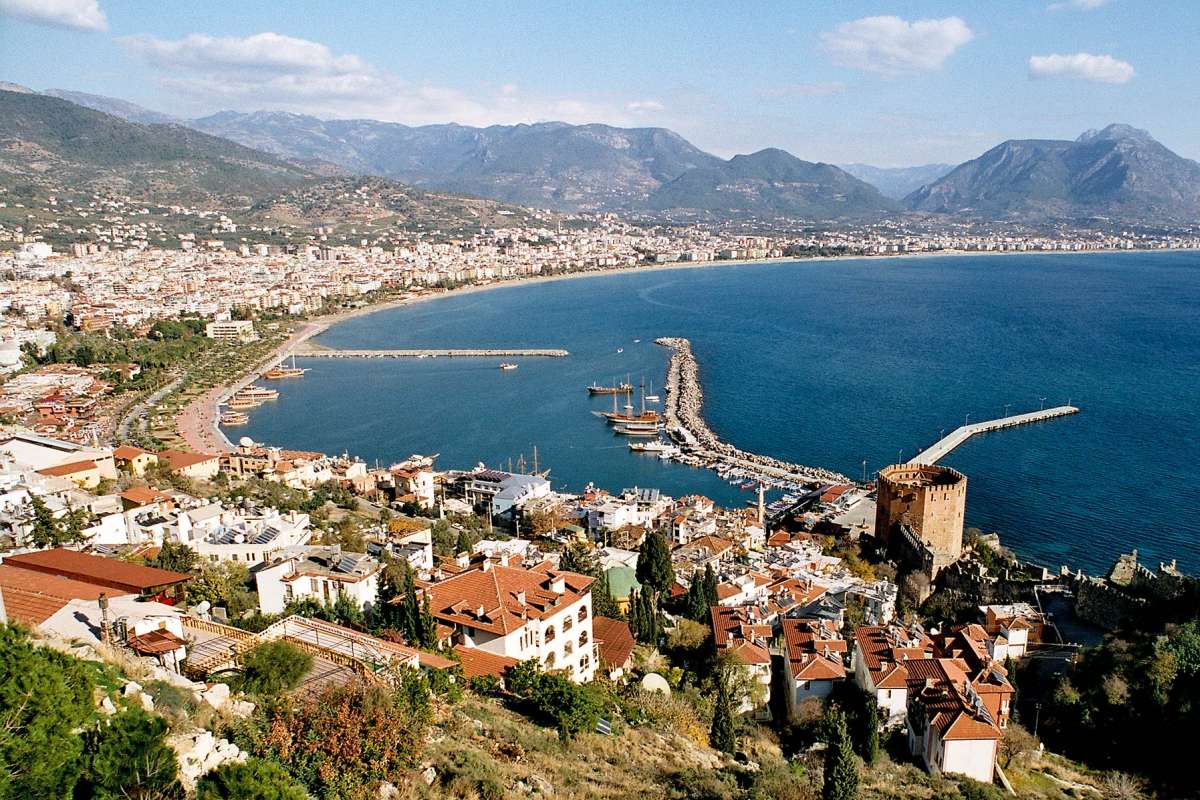If Turkey has a an exotic version of a bucket and spade seaside resort, Alanya on its south eastern coast is it. Its lovely white sand beaches are lapped by the warm waters of the Mediterranean sea and overlooked by the towering Taurus mountains. And as you follow its coastal curve and meander inward too, the mood perceptively changes from historic to bizarre, lively and amusingly, a little cheesy too.
Along the harbour are myriad restaurants, some named after celebrities such as James Dean and Elvis and an open-air segment of cafés, dubbed the tea rooms, that look onto the tens of moored ships. Some of these are private yachts and some take tourists out to sea. Smaller ones dressed in yellows, reds and orange bob on their laurels, offering a colourful eyeful against the deep blue of the sea.
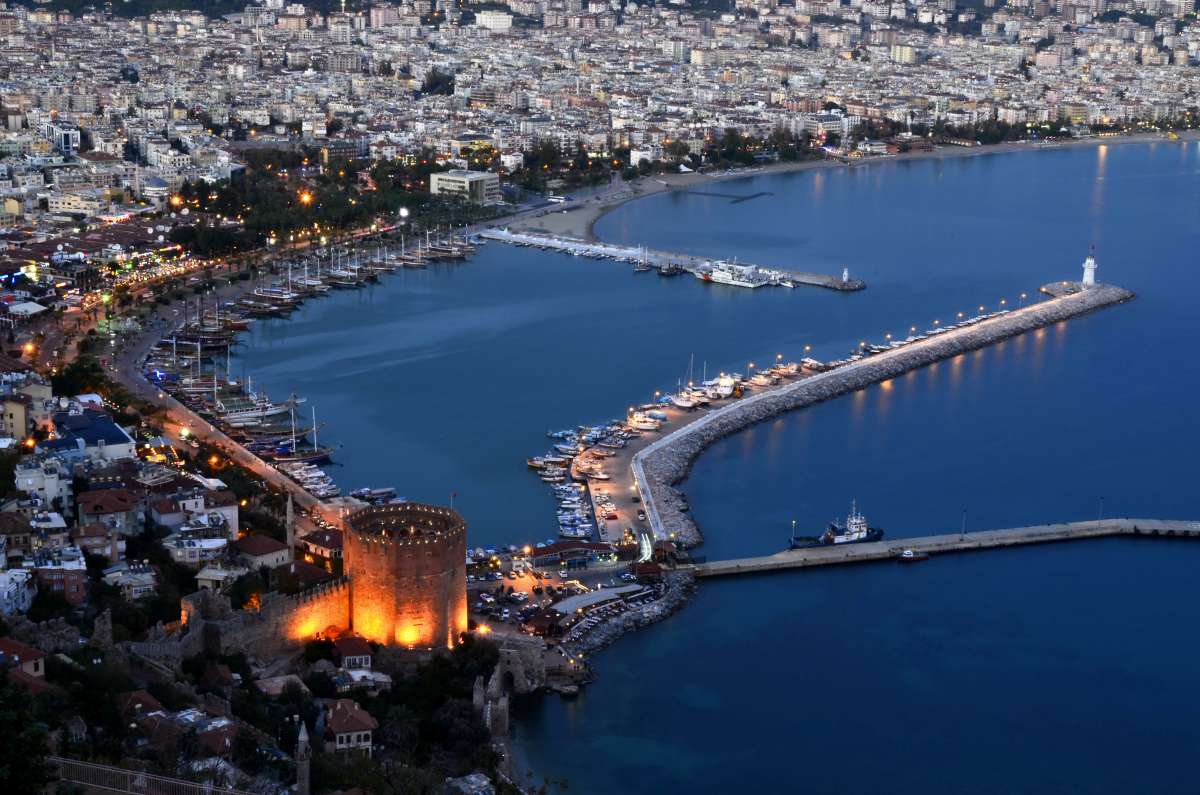
Alanya by night
One sun-scorched afternoon, I found myself on the Sea Angel, a wooden pirate ship that looked twee with its a statue of a a silver angel. With Kapten Arif at the helm I was was about to spend four-hours with a rather large gaggle of Russian, German and Dutch tourists. Party music escaped from some overhead speaker while the crew-cum-gymnasts served and entertained. The ship anchored every now and again so we could jump ship and swim in the warm sea water and as we sailed by Alanya’s rich heritage of coves and caves (Phosphorus being the most famous), crew members took to diving off them in all manner of daredevil ways. Even dolphins turned up on cue to a collective joy. A lunch of skewered chicken followed by juicy watermelon was remarkably good. Though not a sophisticated jaunt, young families and those young at heart may find this to be tremendous fun.
Yet everywhere I looked I was reminded that this is an historic town. It’s 13th century castle, built by Seljuq Sultanate of Rum on a rocky peninsula, is perched 820 feet high. It’s now an open-air museum with a palace, villas and a chapel that was converted into a mosque and is testament to a long history of invasions including the Ptolemaic, Seleucid, Roman, Byzantine, and Ottoman Empires.
Built by Seljuq Sultanate of Rum on the rocky peninsula part it includes villas and a chapel that was converted into a mosque. Part of the peninsular juts out onto the Mediterranean sea and this is where “man throwing ledge” remembers the gory story of slaves being pushed to their death. Slaves would be given three stones to throw into the sea. If the stones made a splash (an impossible task thanks to the rock formations) they would live another day, if not they would be thrown to their death.
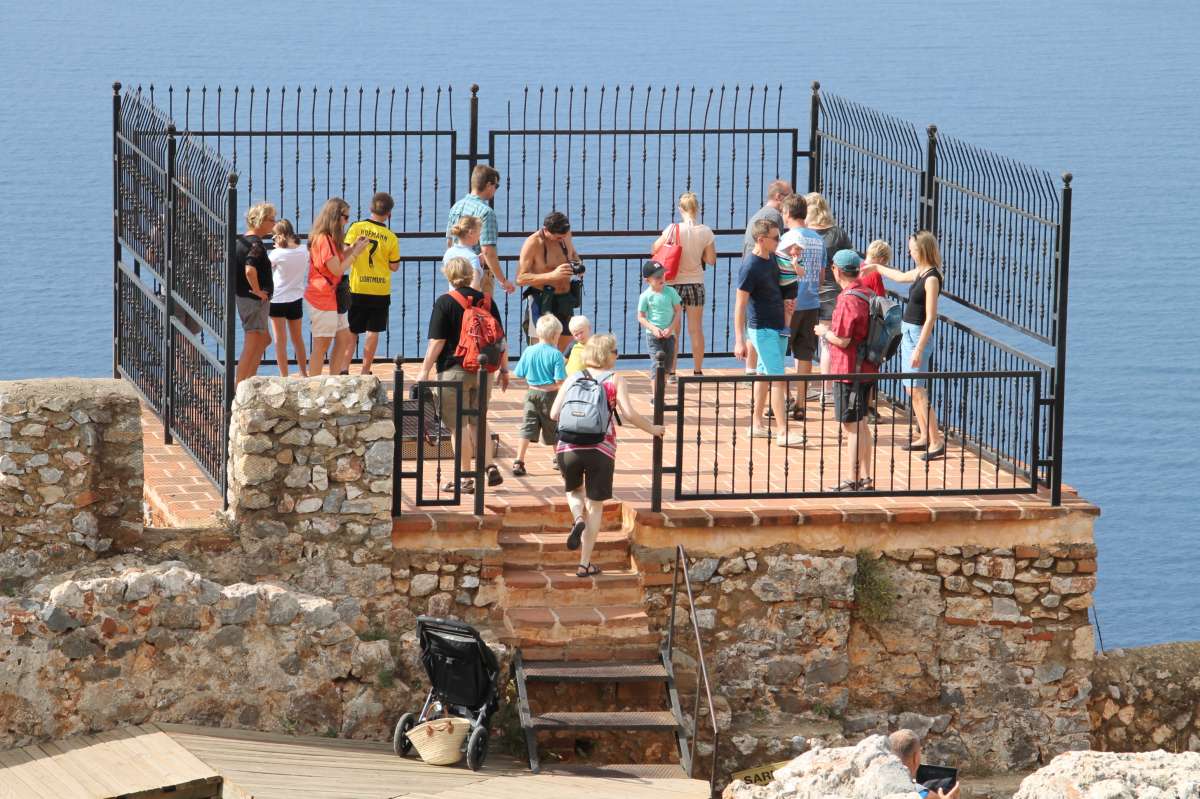
A panoramic view, Alanya
Following the winding floral stone path downwards I was stopped in my tracks by Che Sukru. Clad in just a pair of shorts, his tanned torso was bent over a hand operated juicer making pomegranate juice that he sold for couple of lira a glass. Drinking the juice in his garden café shaded by mandarin and lemon trees while chickens clucked and pottered, was an experience that was beyond quaint.
Following the path as it twisted down to ground level I was led to the now defunct but still fascinating arches of the Tersane shipyard. It serves as a museum to this bygone industry with part-built ships, maps and information describing how it may have been.
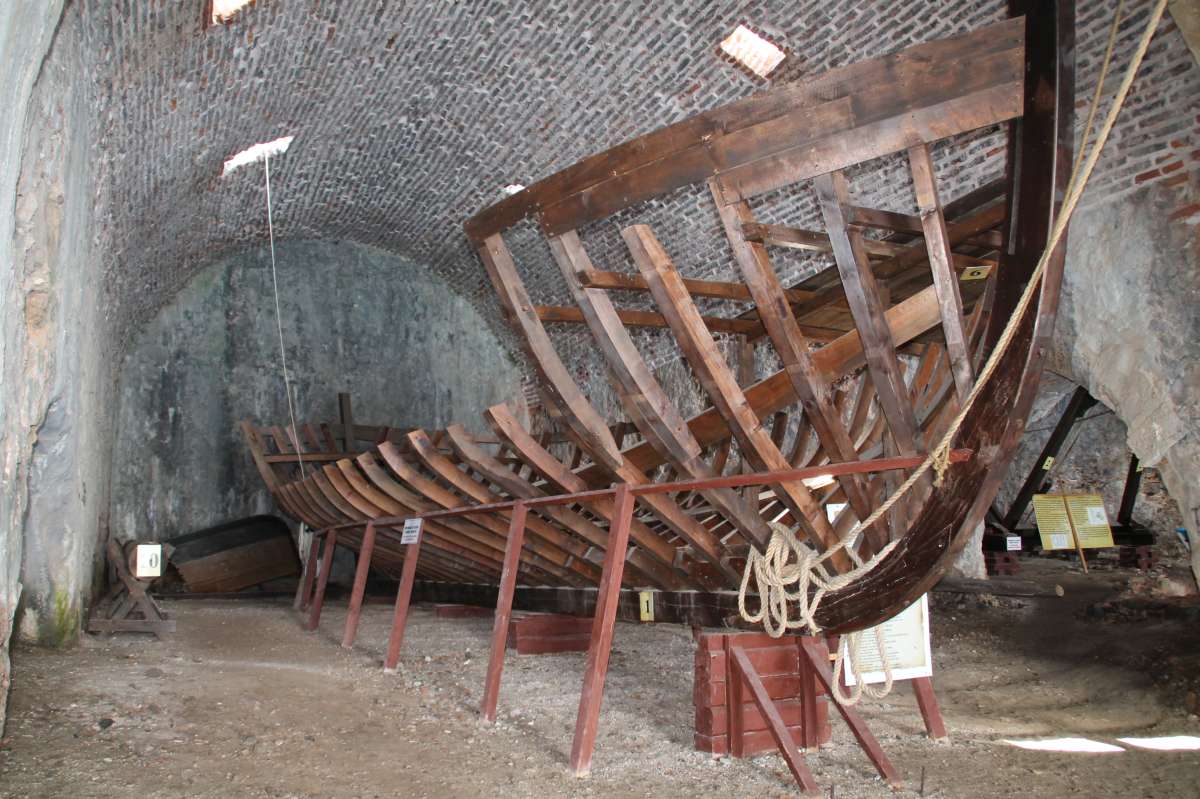
Tersane shipyard, Alanya
Nearby and standing to attention in the harbour is the 13th century octagonal landmark Kızılkule (Red Tower) so called because of its red bricks. Built to protect the town from attack, there are five floors each with a museum of artefacts. Climbing all 86 steps to the roof means getting sensational views over the marina and the beaches.
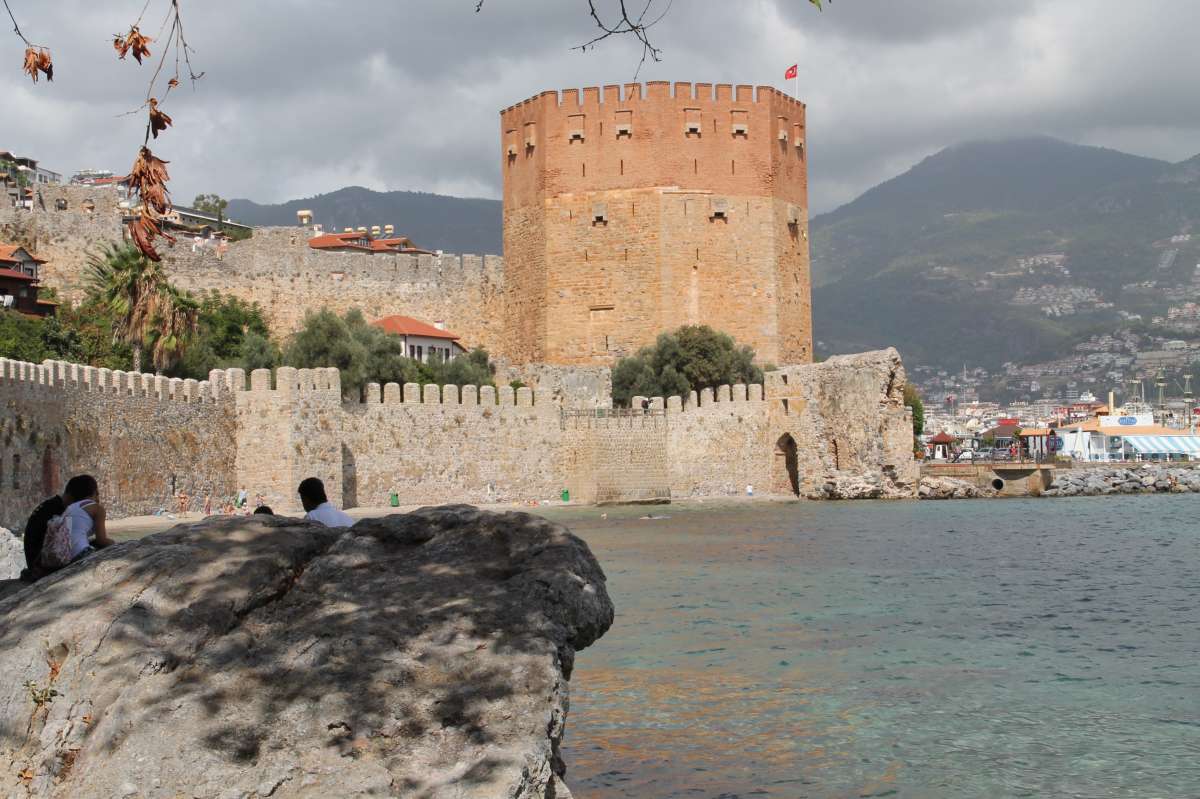
Alanya Red Tower
Reaching the town from the harbour means walking through a bizarre cat sanctuary where stray cats can tuck into bowls of food and shelter in purpose built hutches. It’s part of a serene park where fountains flow while felines and people mingle in quiet reverie.
Just beyond that is a sprawling warren of tiny streets laced with numerous of shops selling fake designer bags, clothes and shoes. Michael Korrs, Prada, Chanel populated the shelves with the odd smattering of Mulberry. It’s common to haggle and it’s impossible to resist.
Amid these streets, restaurants and bars are plentiful with Bar Street being the hotspot for a pulsating night life. It’s also round here that I lunched at Mini Mutfak, a fabulous Turkish restaurant where lamb Kofta (meatballs) never tasted so good and I simply loved the Yavalama – mint beef balls with small chick peas in tzatziki sauce.
Beyond these tiny roads is the main road, Ataturk Street named after Mustafa Kemal Atatürk (1881-1938) a Turkish army officer, revolutionary, and the first President of Turkey who founded the Republic of Turkey. There is an impressive statue of him at the central crossroads where the Turkish flag flies at full mast. Indeed, most buildings in Alanya have the Turkish flag hanging from them.
There are long stretches of beach and perhaps the prettiest is Cleopatra beach. It’s in front of Dalmatas Cave (a tiny two storey cave with impressive stalactites and stalagmites). They say it was named after the Egyptian Queen who stopped by and enjoyed a swim in this bay. Had she done so today she could have also lazed on a comfy cabana or sipped her tipple at a choice of beach side cafes.

Cleopatra Beach, Alanya (c) flickr/Joonas Plaan
One day I joined a jeep tour – a convoy of 18 jeeps filled with people who were encouraged to throw water at each other. I couldn’t fathom out why but on the bright side we clapped eyes on gorgeous pine forests, banana and cotton plantations as we trucked our way through the dirt tracks of the Taurus mountains We stopped for a bbq lunch alongside Dim River and visited an old village to have a peep inside an ancient mosque.
A more sedate day out was to Dim Caye for lunch. Al-freso restaurants are stretched out over the Dim river on platforms. Some restaurants allowed diners to fish for trout for their lunch. Not so at Gol Piknik, where we were seated on cushions and served Turkish cuisine served to a backdrop symphony of a waterfall and the quacking of passing ducks. After a quick finger check of the cold water temperature and I resolved to stay on dry land, though I did spot others – adults and children – splashing and frolicking around the river flumes.
There is a weekly bazaar that takes place in town and although mostly a food and vegetable market with the odd vendor selling flags, it offered a reassuring snapshot of local life.
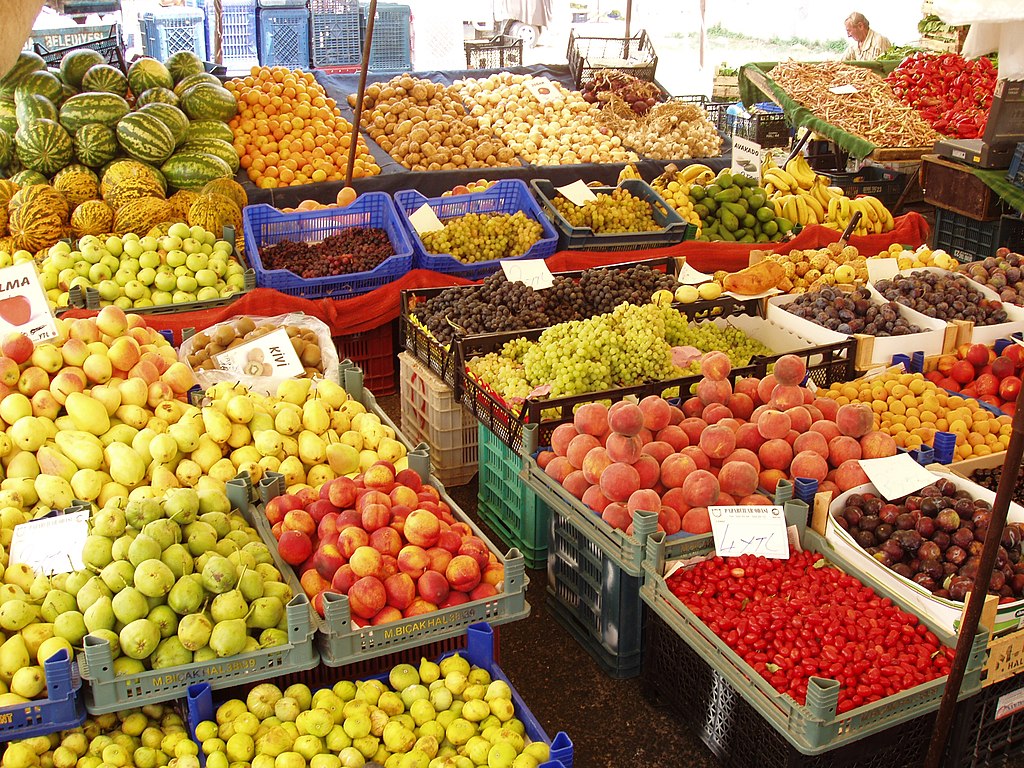
Fruit market in Alanya (c) wikimedia/NobbiP
That afternoon I visited a uniquely Turkish venue, a local Hammam. My lack of Turkish banter was of no concern because no words needed – a knowing look at reception led to a wet sauna followed by dry heat followed by a long dip in a swirling hot tub followed by an eye-watering pummelling given by a slight lady who you’d think couldn’t hurt a fly and soapy deep clean scrub. After a short rest, presumably to recover, a lovely massage pieced me back together again.
It felt truly exotic.
Where to Stay in Alanya
I stayed in a private luxury villa in the hills above Alanya offered by 5 Star Villa Holidays – read my review: Villa Review: Dream Villas, Alanya, Turkey
Other recommended options are Grand Okan Hotel (great for families) and Sunprime C-Lounge (adult-only all-inclusive hotel).
How to Get to Alanya
I flew with Monarch, the scheduled leisure airline, which operates flights to Antalya from London Gatwick in the summer and Leeds Bradford in the winter with fares, including taxes, starting from £40 one way (£104 return).
Alanya is about 115 km from Antalya Airport and 40 km from Gazipasa Airport. You can either catch the bus from the airport to the city, or rent a car, giving you the freedom to explore further afield and, like me, to consider accommodation slightly outside the city centre.

